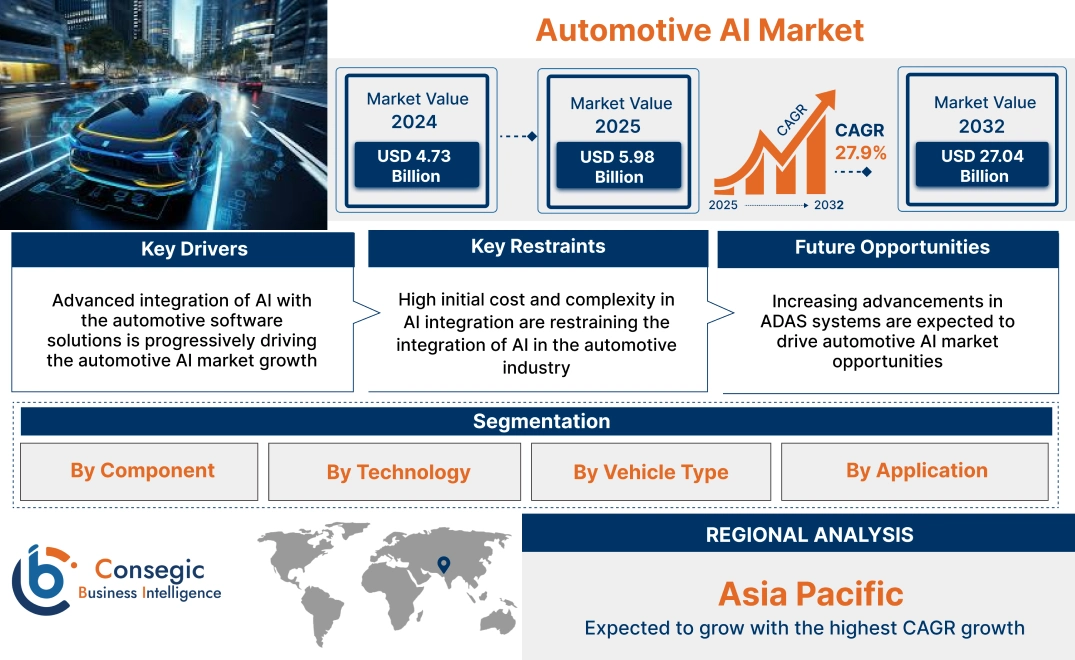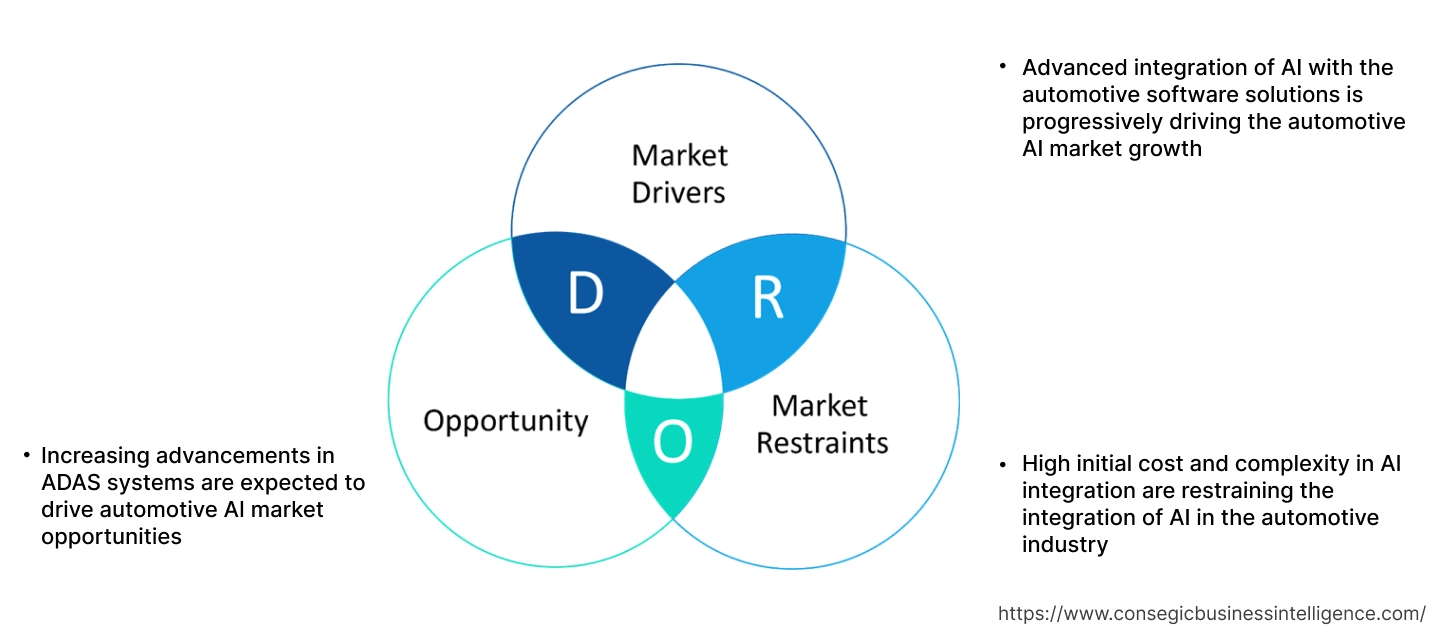Automotive AI Market Size:
Automotive AI Market size is estimated to reach over USD 27.04 Billion by 2032 from a value of USD 4.73 Billion in 2024 and is projected to grow by USD 5.98 Billion in 2025, growing at a CAGR of 27.9% from 2025 to 2032.
Automotive AI Market Scope & Overview:
Automotive AI (artificial intelligence) associates with implementation of AI technologies to enhance various aspects of vehicles, ultimately aiming to improve safety, maximize efficiency and overall driving experience. Moreover, the integration of AI in automotive service enables vehicles to navigate, control, adapt and predict potential issues and maintain it proactively. Additionally, AI stimulates vehicle performance and enhance customer performance by implementing voice assistance and natural language processing, which gives hands free control of vehicle functions and improve optimization of the vehicle. Furthermore, automotive AI integrates with software that enhances the user experience and enables seamless connectivity between the vehicle and the outside world.
Automotive AI Market Dynamics - (DRO) :
Key Drivers:
Advanced integration of AI with the automotive software solutions is progressively driving the automotive AI market growth
Automotive software solution encompasses all the software applications and systems used in advanced vehicles. Moreover, automotive software solutions comprises of advanced driver assistance system (ADAS), infotainment systems, predictive maintenance, battery management system, telematics and others. Moreover, benefits of AI in automotive sector includes improved safety, predictive maintenance, enhanced driver experience, autonomous driving and others. Advanced vehicles heavily rely on AI as it frequently incorporates with the driver assistance technology, which accurately detects whether the driver is fatigue by monitoring their eyes. Features like mirror locks, power seats, anti-lock brakes, airbags and blind spot detection heavily on electronics. Overall, the advancements of AI plays a crucial role in automotive sector, resulting in the market demand.
- For instance, in March 2025, Nvidia Corporation launched Nvidia Halos, which is a comprehensive safety feature to ensure safe developments of autonomous vehicles integrating the cloud to the car.
Thus, the rising integration of AI with the automotive software solutions is driving the automotive AI market size.
Key Restraints:
High initial cost and complexity in AI integration are restraining the integration of AI in the automotive industry
Integration of AI in autonomous vehicles increases operational efficiency of the vehicle, however, the infrastructure comes with high initial costs. Moreover, the high cost of AI integrated vehicles are often passed on consumers in the form of high vehicle cost, which can discourage the potential buyers.
Furthermore, developing and preserving computer infrastructure including sensors, storages, and processors can be expensive. The complexities associated with AI integration in automotive sector includes managing vast amount of data, ensuring safety and security, handling data, privacy breaches, potential vulnerability in autonomous systems and others. Therefore, high initial cost and complexity in AI integration are restraining the market expansion.
Future Opportunities :
Increasing advancements in ADAS systems are expected to drive automotive AI market opportunities
ADAS systems are technologies that assists drivers through a human-machine interface which uses sensors and cameras to detect obstacles or driving errors. Moreover, features such as blind spot monitoring, driver’s drowsiness detection, forward collision warning, parking sensors, intersection assistants, intelligent speed adaption and others are primary factors for adoption of AI in automotive service. Additionally, one of the key feature of ADAS includes its automotive night vision system in visual and environmental monitoring. Automotive night vision enables vehicles to detect obstacles and pedestrians to avoid collision and accidents. Further, in adverse condition when the driver has low visibility various, technologies such as lidar and radar helps detect pedestrians and non-human obstacle. Hence, increasing advancements in ADAS system are expected to drive the automotive AI market opportunities.
- For instance, in January 2025, Hexagon’s manufacturing intelligence division launched its new cloud native solution for testing, training, and validating ADAS systems and autonomous vehicle systems.
Therefore, increasing advancements in the ADAS system are expected to boost the automotive AI market size during the forecast period.
Automotive AI Market Segmental Analysis :
By Component:
Based on component, the market is segmented into hardware and software.
Trends in the component:
- Increasing technological advancements associated with integration of AI in automotive market are driving the market demand.
- The rise in adoption of AI processors in modern vehicles are propelling the market adoption.
Hardware segment accounted for the largest revenue in the overall automotive AI market growth in 2024.
- In automobile AI, hardware includes specialised AI processors such as system-on-a-chip (SoCs), graphic processing units (GPUs), neural processing units (NPUs) and others.
- Moreover, AI chips and sensors are used in ADAS and autonomous driving (AD) to process data from the camera, lidar, radar and others.
- Additionally, GPUs are highly used in AI due to their ability to handle large amount of data and design for rendering graphics.
- For instance, Waymo utilizes a single integrated system of sensors such as lidar, which paints a 3D picture of the surroundings for crash avoidance. Moreover, Waymo performs comprehensive analysis on the hardware, behavioral and embedded software controls to avoid accidents.
- Therefore, hardware plays an important role in the automobile AI sector, further driving the market.
Software segment is anticipated to register a substantial CAGR development during the forecast period.
- In automobile AI, software facilitates advanced technologies such as ADAS and AD, which are collection of technologies that are used in integration with camera, sensors, and detection systems.
- Moreover, sensor data fusion enables various data to be embedded through inertial measurement unit (IMUs), radars and others to improve accuracy.
- For instance, Bosch offers sensor fusion software in its solution offering. Bosch SensorTec provides dynamic and accurate orientation of the target platform.
- Therefore, the rising advancements associated with AI software are expected to drive the market during the forecast period.
By Technology:
Based on technology, the market is segmented into machine learning and deep learning, computer vision, natural language processing and others.
Trends in the technology:
- Autonomous vehicles are one of the prime innovations of machine learning and deep learning, driving the adoption of automotive AI market.
- Rising trend in utilization of natural language processing in the automotive sector for facilitating autonomous features is driving the automotive AI market.
Machine learning and deep learning segment accounted for the largest revenue in the overall automotive AI market in 2024.
- By integrating machine learning (ML) algorithms and deep learning models, automotive has boosted its capacity to operate on voluminous data.
- However, self-driving cars and smart energy systems, plays a crucial role in applications such as ADAS, predictive maintenance and others.
- Various ML algorithms that are used in autonomous driving are perception algorithms, localization algorithms, mapping algorithms, particle filters and others.
- For instance, in July 2024, SoundHound AI, Inc. launched its voice assistant with integrated ChatGPT in automobile brands such as Peugeot, Opel, and Vauxhall around 11 European market.
- Therefore, the rise in advancements associated with machine learning and deep learning technologies are driving the automotive AI market demand.
Natural language processing segment is anticipated to register a substantial CAGR growth during the forecast period.
- Natural language processors (NLP) implements voice recognition feature to share real time alerts and assist driver accordingly.
- Moreover, the activation of NLP in ADAS warns drivers of the possible obstacles or hazards on the road.
- NLP can also share timely information with recommended solution if the driver is unaware about the vehicle issue including mechanical failure.
- By analysing different types of data input, NLP is able to recognise driver’s health condition for instance drowsiness.
- For instance, BMW launched its personal assistant where in it is able to understand user’s moods and commands giving appropriate solution to it. Personal assistant has the understanding of every detail of user’s car from servicing requirements to fuel levels.
- Therefore, the rising adoption of NLP in automotive sector is projected to drive the market during the forecast period.
By Vehicle Type:
Based on vehicle type, the market is segmented into passenger cars, light commercial vehicles, and heavy commercial vehicles.
Trends in the vehicle type:
- There is a rise in adoption of semi-autonomous and autonomous vehicles, which is further propelling the market demand.
- Increasing utilization of AI in heavy commercial vehicles to support automated features is driving the global automotive AI market.
Passenger cars accounted for the largest revenue share of 66.42% in the automotive AI market share in 2024.
- Artificial intelligence in passenger cars plays a vital role in enhancing safety and drivers experience from applications such as advanced driver assistance systems.
- Moreover, infotainment systems provides various recommendations for in-car features such as music, seat belt sensor, navigation and others.
- Moreover, AI helps to monitor and maintain speed while providing users with warnings accordingly. It also assists on lane departure warning when users unintentionally drift from the lane.
- For instance, according to the analysis by International Organization of Motor Vehicle Manufacturers (OICA), Asia-Pacific region witnesses an increase of 17% in total passenger car sales in 2023 as compared to 2019.
- Therefore, rising passenger cars sales are driving the automotive AI market trends.
Heavy commercial vehicles is anticipated to register a substantial CAGR growth during the forecast period.
- Heavy commercial vehicles utilizes AI to optimize operations such as improved safety, enhanced operations, navigation and others.
- Moreover, AI features that are used in heavy commercial vehicles include automated routing and dispatch, safety compliance integration, automated workflow, advanced driver assistance technology and protection of data and systems.
- Additionally, NLP is used in heavy commercial vehicles to assist navigation and provide warning for lane switch.
- For instance, according to the analysis OICA, the production of heavy trucks in Europe reached 423,359 units in 2023, representing the increase of 33% from 2022.
- Hence, the rising production of heavy commercial vehicles is anticipated to boost the automotive AI market trends during the forecast period.
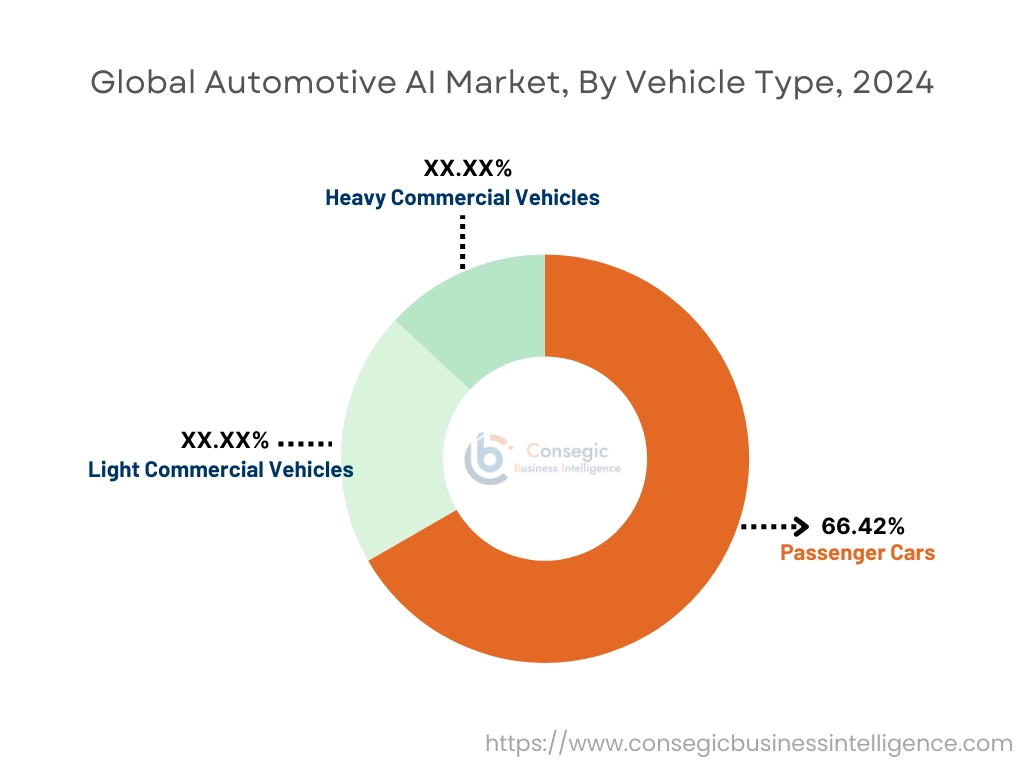
By Application:
Based on application, the market is segmented into autonomous vehicles and semi-autonomous vehicles.
Trends in the application:
- The rapid adoption of AI in the semi-autonomous vehicles, driven by the technological advancements, is boosting the market growth.
- Rising trend in utilization of autonomous vehicle solutions for increasing operational safety and efficiency.
Semi-autonomous vehicles accounted for the largest revenue in the overall automotive AI market share in 2024.
- Semi-autonomous vehicles also known as partial automation, uses advanced technology to assist drive with certain tasks such as lane keeping but it still requires human to oversight operations.
- There are two levels of automation, one is partial automation where the vehicle can perform some tasks autonomously but compulsory requires a driver.
- Moreover, another level of automation is conditional automation, where the vehicle can handle specific conditions, allowing the driver to overtake when required.
- For instance, Bosch Mobility offers solutions for road sign information assistance by displaying road sign information of nearby signs in the driver’s view. This can be integrated in semi-autonomous vehicles to assist the driver while they drive.
- Therefore, the rising advancements associated with AI for integration in semi-autonomous vehicles are driving the market growth.
Autonomous vehicles is anticipated to register a substantial CAGR growth during the forecast period.
- Autonomous vehicles are vehicles that can drive with minimal human- intervention with the help of sensors and technology
- Moreover, autonomous vehicles uses sensors like radar, lidar, and cameras to understand their surroundings and take decisions accordingly.
- Additionally, autonomous vehicles use adaptive cruise control, anti-braking system and GPS navigation with the integration of artificial intelligence.
- For instance, Nvidia DriveOS is an automotive AI operating system designed to meet advanced AI inference, advanced graphics, high end audio and complex safety, and security for the users. DriveOS is also capable of supporting autonomous driving and AI-powered cockpit experiences.
- Thus, rising advancements in autonomous vehicles are anticipated to drive the market during the forecast period.
Regional Analysis:
The regions covered are North America, Europe, Asia Pacific, the Middle East and Africa, and Latin America.
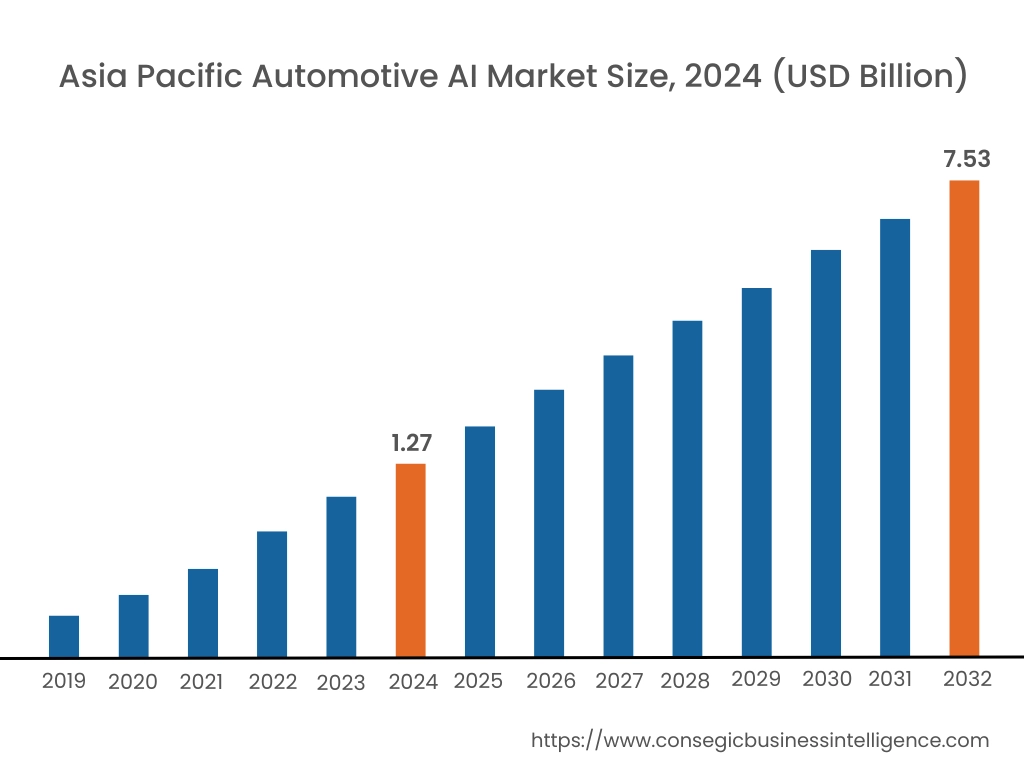
Asia Pacific region was valued at USD 1.27 Billion in 2024. Moreover, it is projected to grow by USD 1.62 Billion in 2025 and reach over USD 7.53 Billion by 2032. Out of this, China accounted for the maximum revenue share of 38.58%. As per the automotive AI market analysis, there is an increasing adoption of AI in the automotive market in the Asia-Pacific region for improving operational efficiency. Additionally, increasing investments in autonomous vehicles sector are further accelerating the automotive AI market expansion.
- For instance, according to the Society of Indian Automobile Manufacturers, the production of passenger cars reached 49,01,844 units in FY 2023-24. The above factors are driving the market in Asia-Pacific region.
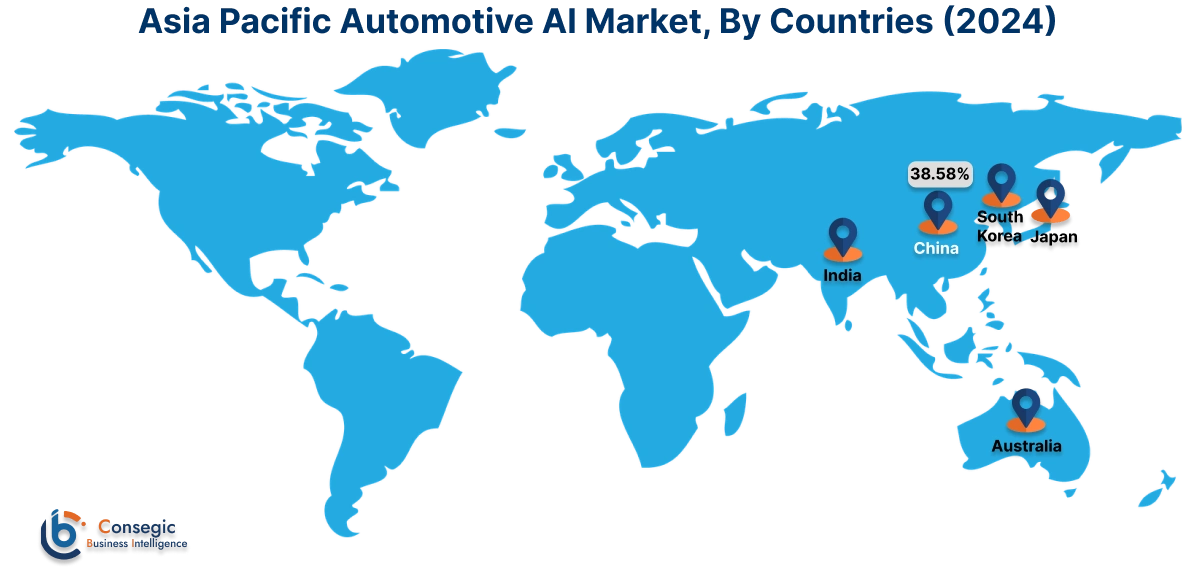
North America is estimated to reach over USD 9.25 Billion by 2032 from a value of USD 1.62 Billion in 2024 and is projected to grow by USD 2.05 Billion in 2025. In North America, the rise in adoption of automotive AI service is driven by rising adoption of technology and increasing development of autonomous vehicles in the region. Similarly, rising advancements related to machine learning and deep learning are contributing to the automotive AI market demand.
- For instance, according to OICA, the production of heavy trucks in North America reached 562,244 units in 2023, representing an increase of 7% from 2022.
Additionally, the regional analysis depicts that the prevalence of favorable government measures for facilitating autonomous driving and increasing investments in automotive AI are driving the automotive AI market expansion in Europe. Further, as per the automotive AI market analysis, the market demand in Latin America, Middle East, and African regions is expected to grow at a considerable rate due to increasing investments in automotive manufacturing and rising adoption of machine learning and deep learning technologies in vehicles among others.
Top Key Players and Market Share Insights:
The global automotive AI market is highly competitive with major players providing solutions to the national and international markets. Key players are adopting several strategies in research and development (R&D), product innovation, and end-user launches to hold a strong position in the automotive AI industry. Key players in the automotive AI industry include –
- ai (U.S.)
- NVIDIA Corporation (U.S.)
- Tesla Inc. (U.S.)
- Pony AI Inc. (China)
- UVeye Inc. (U.S.)
- Toyota Motor Corporation (Japan)
- Valeo SA (France)
- Intel corporation (U.S.)
- Here international B.V. (Netherlands)
- Bayerische Motoren Werke AG (BMW)(Germany)
- Qualcomm Incorporated (U.S.)
- Waymo LLC (U.S.)
Recent Industry Developments :
Product Launches:
- In February 2025, Stellantis launched AI-powered in-car assistant. Moreover, AI-powered in-car assistant allows drivers to interact with vehicle using a natural language. Additionally, the AI assistant acts as a real-time, voice enabler user manual which allows drivers to ask and receive warning indicators and troubleshoot features, ensuring seamless and intuitive user experience.
Automotive AI Market Report Insights:
| Report Attributes | Report Details |
| Study Timeline | 2019-2032 |
| Market Size in 2032 | USD 27.04 Billion |
| CAGR (2025-2032) | 27.9% |
| By Component |
|
| By Technology |
|
| By Vehicle Type |
|
| By Application |
|
| By Region |
|
| Key Players |
|
| North America | U.S. Canada Mexico |
| Europe | U.K. Germany France Spain Italy Russia Benelux Rest of Europe |
| APAC | China South Korea Japan India Australia ASEAN Rest of Asia-Pacific |
| Middle East and Africa | GCC Turkey South Africa Rest of MEA |
| LATAM | Brazil Argentina Chile Rest of LATAM |
| Report Coverage |
|
Key Questions Answered in the Report
How big is the automotive AI market? +
The automotive AI market was valued at USD 4.73 Billion in 2024 and is projected to grow to USD 27.04 Billion by 2032.
Which is the fastest-growing region in the automotive AI market? +
Asia-Pacific is the region experiencing the most rapid growth in the automotive AI market.
What specific segmentation details are covered in the automotive AI report? +
The automotive AI report includes specific segmentation details for component, technology, vehicle type, application, and region.
Who are the major players in the automotive AI market? +
The key participants in the automotive AI market are Cerence.ai (U.S.), NVIDIA Corporation (U.S.), Here international B.V. (Netherlands), Intel corporation (U.S.), Valeo SA (France), Bayerische Motoren Werke AG (BMW)(Germany), Qualcomm Incorporated (U.S.), Waymo LLC (U.S.), Tesla Inc. (U.S.), Pony AI Inc. (China), UVeye Inc. (U.S.), Toyota Motor Corporation (Japan) and others.
